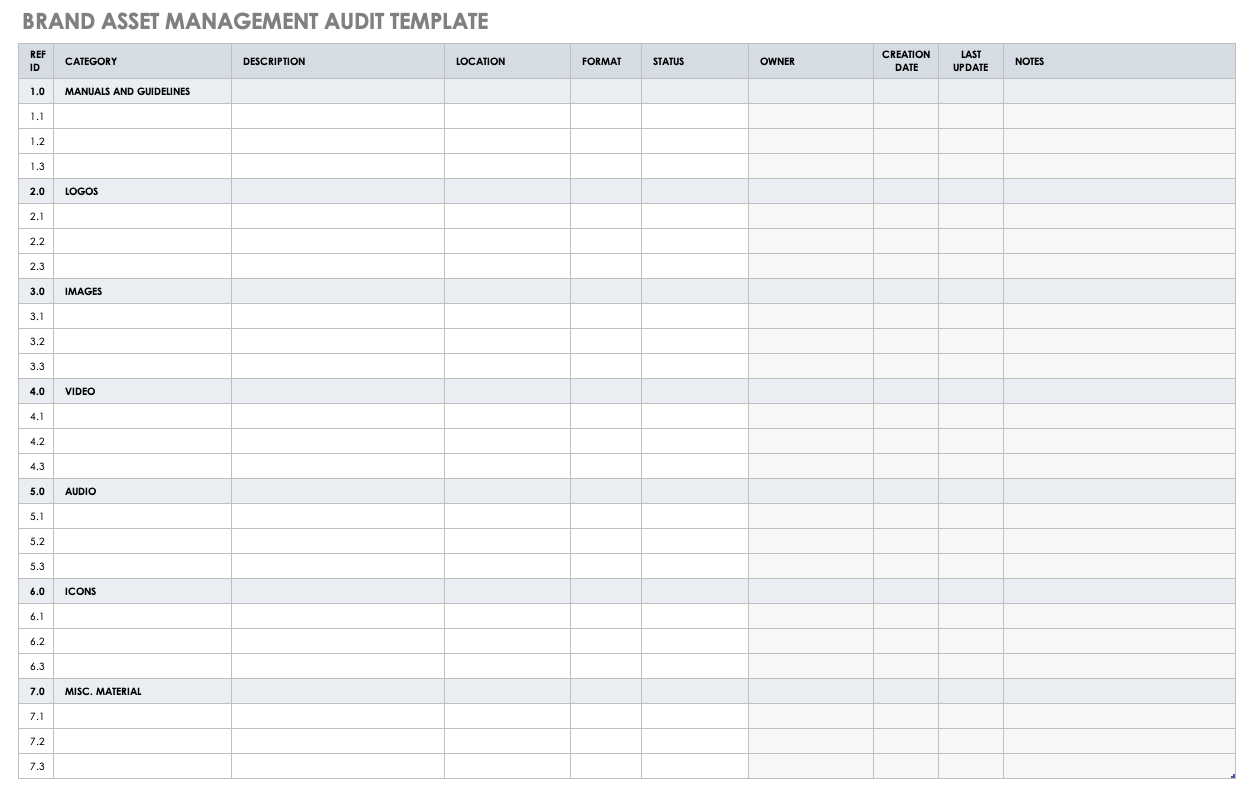What Is Brand Asset Management?
Brand asset management (BAM) is the first step in ensuring that you have organized, stored, and made available your brand’s unique, differentiating characteristics in order to attract prospects, sell your product, and retain customers.
Maintaining consistent brand guidelines, including appearance and messaging, is the foundation for developing a credible, consistent, recognizable brand. Branding information includes some of the most apparent brand elements, such as brand guidelines, logos, colors, value proposition, and tagline. A company’s central BAM database should house the most up-to-date version of each brand file and resource, and these assets should be made available for editing and distribution — access to brand assets is crucial in order for global organizations to guarantee consistency and localization across regions and countries.
What Are Distinctive Brand Assets?
The phrase distinctive brand assets refers to assets that provoke recognition through consistent use. A logo, such as the Nike swoosh, is a distinctive asset that is unique and prevalent across everything Nike distributes, from sneakers to t-shirts and water bottles. The brand recognition of this particular logo is so powerful that Nike products often display the swoosh without the actual brand name. A voice, shape, tagline, or celebrity endorsement is also an identifier that may be distinct to a specific brand.
Digital Asset Management vs. Brand Asset Management
Digital assets and brand assets are often one and the same. However, while digital asset management (DAM) is designed to organize assets across an organization, brand management is focused specifically on content that includes brand information.
What it really comes down to is brand assets are a subset of digital assets. As creative projects and marketing campaigns take shape, easy access to those assets (and only the approved versions) creates more efficient processes and a more consistent brand experience. By establishing a single-source-of-truth for all stakeholders, a digital asset management system is integral to successful brand management overall.
Jason Stum, Director of Strategy at Dealer Inspire, states that "Our company has grown; fast. We've always prided ourselves on being nimble, but the larger any org gets, the more challenging it can be to keep your client facing teams speaking the same brand language. As we grew it became apparent that keeping all of our collateral in a folder on Google Drive wasn't going to be scalable. Luckily, our company turned to DAM and it's been an integral part of keeping our teams aligned with the latest and greatest materials we have available."
Benefits of Brand Asset Management
Your brand identity is essential, especially in today’s increasingly competitive marketplace. Adopting a BAM strategy and solution dramatically impacts the productivity of multiple business units by making assets in multiple formats easy to find and access.
In order to support your marketing, sales, creative, and other teams, you need to develop and manage your brand by ensuring that all assets are brand-compliant, monitoring usage, and maintaining and enforcing guidelines.
Brand managers at companies with extensive libraries of branded materials typically share branded assets with other departments or with distributors, vendors, partners, dealers, and agencies.
“As a product marketing vendor, I frequently develop marketing resources for technology companies,” says Elisabeth Cullivan Thomas, Founder of Launch Product Marketing. “It’s beneficial when the internal team can quickly point me to the most up-to-date brand guidelines or give me direct access to all brand resources. This kind of access ensures that we accurately and consistently represent the company voice and its product names across all resources.”
The ability to share from a single source of truth simplifies access, improves collaboration, and ensures brand consistency. Furthermore, in the case of a merger, acquisition, or takeover, you can easily audit and update brand assets when they’re stored in a centralized location. For example, a BAM system can help do the following:
- Safeguard your brand and accelerate brand growth.
- Ensure consistent brand usage to build brand equity and integrity.
- Represent your brand clearly and positively.
- Reduce redundant work and duplicate files.
- Boost communication across internal departments and with external users.
Many organizations develop a partner portal for external, third-party access to branded assets. Often, these organizations will provide their external stakeholders with flexible personalization options without compromising their brand.
Brand Asset Management Software Solutions
The benefits of BAM are clear, but how do you find a solution that will manage your unique brand assets? BAM software solutions are available in cloud, on premises, or hybrid deployments, and you will find a variety of price points and feature sets. However, most BAM software is part of a more extensive DAM solution. The best way to select a BAM system is to identify your business requirements, including who will use the solution, the types of assets you will store, and the locations from which users will access the assets.
Some of the most popular BAM solutions are Wedia, Bynder, Lucidpress, Marvia, Brandworkz, and Canto.
Brand Asset Management Software Features to Consider
There are solutions available to meet almost any need in organizations of any size. Intuitive interface, excellent customer service, mobile support, asset creation, sharing and distribution, search, and security features are a part of almost every solution. Here are some additional features to consider as you explore solutions:
- Customization to fit unique business needs
- Integration with social media and other business solutions
- Project management
- Reputation management
- Video management
- Batch uploading and file format conversion
- Scheduling, automation, approvals, and workflow
- Version control, archiving
- Enterprise governance and security, including copyright tracing, digital rights management, privacy controls, and permissions
- Auto-updating across all asset locations
- Multichannel publications for customer engagement
- Alerts and notifications
- Visual content management with image recognition and automatic tagging
- Online proofing
- Template creation and sharing
- Usage analytics, dashboards, and artificial intelligence (AI)
- End-user portal
- Marketing resource management (MRM)
What Does a Marketing Brand Manager Do?
Have you ever heard of the brand police? If you work in a large organization, you have likely heard that you need a “®” after a company name or tagline, and to add the logo to your email signature. These are some of the first things that may come to mind when you consider the responsibilities of a brand manager.
It is true that one of the primary responsibilities of a brand manager is to ensure that internal and external users adhere to brand guidelines. However, a more vital part of the job is building the reputation of the brand. Consider the Apple brand: Consumers are willing to wait in endless lines for the newest iPhone — even if they’ve just paid $800 for the previous release a year earlier. Creating this kind of brand loyalty is the work of a brand manager, or a team of brand managers, who research the marketplace, understand consumers, and develop strategies, concepts, collateral, and promotional activities that promote the brand. They are creative, look at the big picture, and excel at building relationships and telling stories. Brand managers may not always hold that exact title; they may also be called a brand evangelist, brand facilitator, or brand concierge.
Brand Asset Management Strategy
A BAM strategy is part of the overall brand management strategy, which has the goal of increasing the brand's perceived value.
Before you select or purchase a BAM solution, develop a strategy that will ultimately guide you in your search. Start by auditing your brand assets: Note what you have, where your assets are stored, the format of your assets, and whether they are current or outdated. Identify gaps in the assets. Are there brand assets that are missing, such as brand guidelines? Take note of these “assets to create.” Then, talk with your users from marketing, sales, and leadership to find out what they would like to access (for instance, perhaps they would like a branded email signature). From there, develop a business plan that includes your goals and the BAM system requirements that will help you achieve those goals. Finally, lay out your implementation plan.
Brand Asset Management Audit Template
This brand asset management audit template will help you gain control of existing brand assets. Use this template to gain visibility into the brand assets you currently have, identify gaps in versions, and pinpoint opportunities for new brand assets.
Download Brand Asset Management Audit Template
Brand architect Ashley Libby Diaz shares her top three strategies, based on her work building and managing brands for over fifteen years:
- “Develop a detailed brand guide that outlines all brand elements, including logo details and usage guidelines, along with brand details, such as imagery, positioning, messaging, story, and promise.
- Implement an up-to-date repository of approved brand materials that are accessible to those who need them, including a cataloguing system with revision dates.
- Establish an approval process for new brand materials with appropriate sign-offs.”
Expert Tips for Getting Started with Brand Asset Management
Brand management is critical to ensuring that your company or product image transfers to the market space. If you work for a global organization that has numerous assets spanning a wide variety of versions, formats, and locations, how do you get started?
“Begin by creating a central location where all employees can find all brand communication assets. It should have separate areas for internal and external communications and subcategories, for example by office locations or function,” says Marilyn Heywood Paige, CMO, Paige Black. “Internal assets may be sub-categorized by department or function, such as training and operations. You may categorize external communications by sales, marketing, and client education. Having a well-organized central collection site is the first critical step to wrapping your arms around the challenge of making all your brand communications consistent and cohesive.”
A central BAM repository that is comprehensive, well organized, and accessible is the best tool for creating a notable brand.
Manage Brand Assets with Smartsheet
The best marketing teams know the importance of effective campaign management, consistent creative operations, and powerful event logistics -- and Smartsheet helps you deliver on all three so you can be more effective and achieve more.
The Smartsheet platform makes it easy to plan, capture, manage, and report on work from anywhere, helping your team be more effective and get more done. Report on key metrics and get real-time visibility into work as it happens with roll-up reports, dashboards, and automated workflows built to keep your team connected and informed.
When teams have clarity into the work getting done, there’s no telling how much more they can accomplish in the same amount of time. Try Smartsheet for free, today.

